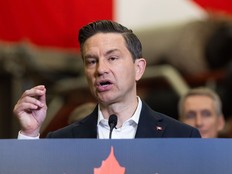Team-based community care aims to solve family doctor shortage
The overarching goal is to create community health hubs that can respond to local needs and address social determinants of health

Article content
This is a daunting problem: As many as 6.5 million Canadians do not have a family doctor or nurse practitioner they can see regularly.
This lack of access is an increasing burden on emergency care services, chipping away at trust in the healthcare system. In fact, the number of unscheduled emergency room visits jumped from about 14 million in 2021-2022 to almost 15.5 million in 2023-2024, according to data from the Canadian Institute for Health Information (CIHI).
Recommended Videos
The pressure is only mounting as an aging and growing population will require more care, while more family doctors are closing their doors to new patients and retiring from practice.
How do you solve this? How can people get access to consistent, quality care?
Part of the answer involves shifting the care model to a team-based, holistic approach. Instead of going to a doctor’s office with one or two family physicians and a busy front-desk clerk, there’s an interprofessional team you’re connected with that contributes to your care.
Collaborative multidisciplinary team spreads and scales care
Healthcare professionals, those training now in medical schools, are the future. They will need to work collaboratively to help a larger number of patients more efficiently. The innovative curriculum in medical school programs reflects this shift away from a traditional care model where people often experience long wait times and limited access to providers.
One term for the team approach is “wraparound care,” says Dr. Jobin Varughese, interim assistant dean of primary care education at Toronto Metropolitan University (TMU) and president of the Ontario College of Family Physicians.
“Wraparound care is family physicians, nurse practitioners, social workers, and even system navigators who are a really important piece because so many people get lost within the system,” he says of social workers and nurse practitioners who help direct people to services. “There’s also registered dietitians and mental health professionals,” along with office and administration staff as part of the team.
“People will see a team that’s there to be their concierge to care.”
New med school offers training in integrated clinics
For example, TMU’s new School of Medicine, which opens this fall, is set up to offer training in integrated healthcare clinics based in the community. Students will work alongside nurse practitioners, pharmacists, and other professionals, learning to lead within collaborative care systems. The aim is for family doctors to stop practicing in a silo, trying to keep on top of different therapy approaches and specialties that are changing rapidly. Now the family doctor will have contact with multidisciplinary providers, sharing their knowledge and professional development.
As Dr. Varughese explains, “It’s going to be an important culture shift to say ‘I’m going to give you even more than just your family physician.’ I’m going to give [patients] a team that allows them to thrive at their best, be their best, and really focus on who is the right provider for the care you need. Because yes, a family physician can provide medication and nutrition advice. But why wouldn’t we supplement that with a registered dietitian and a diabetes education nurse? Why wouldn’t we ensure that those providers who have a specialized level of information help offset some of that time from the family physician, allowing them to see more people?”
The team-based model is one that he’d like to see developed and adopted nationally to help spread and scale care to meet the increasing demands on the healthcare system.
Shift to virtual care services builds capacity
Another part of the equation is transitioning to more virtual care, provided people have access to a device. Dr. Varughese says that promoting health equity is about being more adaptive and recognizing barriers, such as visiting the doctor’s office, which is a significant life event for many people, requiring time off work, the need for someone to accompany them, or arranging childcare.
“There’s an absolute need to meet people where they’re at.”
He’d like to see primary care move toward 30 per cent of practice to be virtual, whether it’s for follow-up appointments or first-time visits. That could look like a triage provider who will be the first point of contact to determine whether people can be seen virtually or require an in-person appointment. Can they be managed over the phone, or do they need to see a physician right out of the gate?
The overarching goal is to create community health hubs that can respond to local needs and address social determinants of health. It’s not just for primary care but also for coordinating health and social services.
“An important thing, as we move toward what the future of primary care looks like, is that it’s rooted in the community that looks to these teams and provides technology for the family physicians” (so they’re not doing hours of paperwork).
This approach would support family doctors who are doing emergency room visits, delivering babies, and making visits to homes and long-term care facilities.
“Maybe they can’t run a practice all the time, but if they can be part of a team that provides them the support to be able to come in and see patients as part of the team care, that will be a huge benefit.”
In this same vein, medical school training is looking at the career longevity of family doctors, recognizing that there are many different ways that these professionals can practice, be it urgent care clinics or splitting service time in hospitals with a shared office practice with flexible hours. TMU is offering multiple styles of practice within its care models. The benefit here is to get ahead of graduates waiting before they start practicing.
“As these learners get out, they’re not having to look around and see what kind of system they want to get into,” Dr. Varughese says. “They would have seen the benefits and risks and made that choice during their training instead of having to wait to figure that out down the road. Because unfortunately, currently we’re seeing a lot of people waiting before they jump into practice.”
Bottom line, we need family doctors to actively practice their profession. In Ontario alone, he says 65 per cent of family doctors surveyed are planning to leave or tighten the scope of their practice in the next five years.
Equipping future doctors with self-care skills to avoid burnout
Dr. Varughese is excited to be part of the new medical school that’s focused on interprofessional education and building capacity into primary care. As a new program in Canada, he says there’s an opportunity to pave the way for change to meet care demands and keep family doctors thriving. He flags wellness and resiliency services in the program that will be foundational in curbing burnout in future doctors.
“We really have the opportunity to build wellness into everything we do instead of a three-hour module on wellness,” he says. The school has a designated provider to check in with students, who is separate from their educational team, for counselling and mental health services.
“We’re building in practice management, wellness, resiliency, and self-care into everything that the residents do throughout their training and being quite intentional with it because it’s the things very commonly we hear from residents is that they don’t get the [emotional support],” he adds.
“We’ve seen more and more physicians starting in practice and leaving practice. So having a way to work toward reducing burnout and aiming for that in a very meaningful way is important.”
-
 How patient simulation is shaping the next generation of healthcare providers
How patient simulation is shaping the next generation of healthcare providers -
 Waterloo, St. George's University team up to address doctor shortage in Canada
Waterloo, St. George's University team up to address doctor shortage in Canada -
 'It's very rewarding to see the difference you can make': Work in health sciences is the sum of all its parts
'It's very rewarding to see the difference you can make': Work in health sciences is the sum of all its parts -
 'Learn by doing': How co-ops and internships shape medical professionals and healthcare
'Learn by doing': How co-ops and internships shape medical professionals and healthcare














